Digital Posters
Imaging Metabolites in the Brain
ISMRM & SMRT Annual Meeting • 15-20 May 2021

| Concurrent 6 | 13:00 - 14:00 |
3713.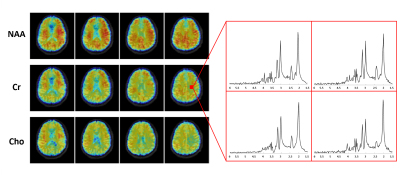 |
Fast High-Resolution 1H-MRSI of the Human Brain at 7T
Rong Guo1,2, Yibo Zhao1,2, Yudu Li1,2, Pallab Bhattacharyya3, Mark Lowe3, Hannes M. Wiesner 4, Yao Li5, Xiao-Hong Zhu4, Wei Chen4, and Zhi-Pei Liang1,2
1Department of Electrical and Computer Engineering, University of Illinois at Urbana-Champaign, Urbana, IL, United States, 2Beckman Institute for Advanced Science and Technology, University of Illinois at Urbana-Champaign, Urbana, IL, United States, 3Imaging Institute, Cleveland Clinic, Cleveland, OH, United States, 4Center for Magnetic Resonance Research, University of Minnesota, Minneapolis, MN, United States, 5School of Biomedical Engineering, Shanghai Jiao Tong University, Shanghai, China
Ultrahigh field systems provide significant SNR benefits to MRSI, but also bring new challenges for accelerated MRSI due to increased spectral bandwidth and larger B0/B1 inhomogeneities. We have managed to overcome these problems and developed a SPICE-based data acquisition and processing technique for rapid, high-resolution spectroscopic imaging of the human brain without water-suppression at 7T. The proposed method can simultaneously obtain metabolite signals at 3.0×3.0×3.0 mm3 resolution and companion water signals at 1.0×1.0×3.0 mm3 resolution with high SNR in a single 8 min scan.
|
|||
 |
3714.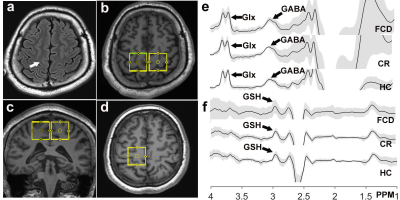 |
GABA Inhibition Enhances in Epilepsy Associated with Focal Cortical Dysplasia
Tao Gong1, Yufan Chen1, Liangjie Lin2, Youting Lin3, and Guangbin Wang1
1Shandong Medical Imaging Research Institute, Shandong University, Jinan, China, 2Philips Healthcare, Beijing, China, 3Departments of Neurology, Shandong Provincial Hospital Affiliated to Shandong University, Jinan, China
The aim of this study was to investigate the metabolic dysfunction of FCD associated epilepsy using Edited MRS. 14 patients and 14 age- and sex-matched healthy controls underwent MR scans, including Hadamard Encoding and Reconstruction of Mega-Edited Spectroscopy (HERMES). The results indicated that GABA levels were significantly increased in epilepsy focal region of patients compared with contralateral regions and healthy controls, while no significant alterations were found in GSH and Glx levels. GABAergic inhibition enhances in FCD foci suggested that GABA may play a central role in the pathophysiology of FCD associated epilepsy.
|
||
3715.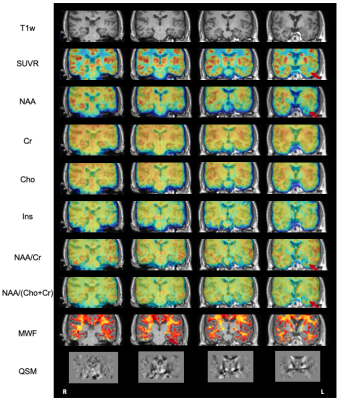 |
Multimodal 1H-MRSI and 18F-FDG-PET in Temporal Lobe Epilepsy
Lihong Tang1, Hui Huang1, Miao Zhang2, Yibo Zhao3,4, Rong Guo3,4, Yudu Li3,4, Zhi-Pei Liang3,4, Wei Liu5, Yao Li1, Biao Li2, and Jie Luo1
1School of Biomedical Engineering, Shanghai Jiao Tong University, Shanghai, China, 2Department of Nuclear Medicine, Ruijin Hospital, Shanghai Jiao Tong University School of Medicine, Shanghai, China, 3Department of Electrical and Computer Engineering, University of Illinois at Urbana Champaign, Urbana, IL, United States, 4Beckman Institute for Advanced Sciences and Technology, University of Illinois at Urbana Champaign, Urbana, IL, United States, 5Department of Neurosurgery, Ruijin Hospital, Shanghai Jiao Tong University School of Medicine, Shanghai, China
NAA decrease and FDG low uptake in cortical and subcortical regions of the limbic system are among the most common findings in temporal lobe epilepsy (TLE) patients. In addition, tissue susceptibility changes in the deep nuclei, myelin water fraction and NAA decrease in white matter bundles might offer complementary information for lateralization. We demonstrated the feasibility of simultaneous high-resolution 1H-MRSI (2.0 x 3.0 x 3.0 mm3), MWF, QSM, and 18F-FDG-PET and investigated potential of the multimodal information for detecting metabolic and microstructural changes in subcortical, cortical and white matter regions for TLE, with results consistent with literature for each modality.
|
|||
3716.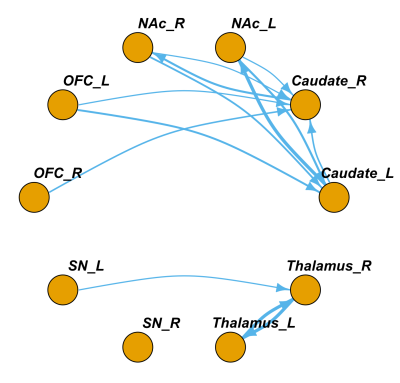 |
Dopamine Directional Circuits Detected by Metabolic Effective Connectivity and Granger Causality using Integrated PET/MR
Lei Wang1, Longxiao Wei1, and Menghui Yuan1
1Nuclear Medicine, Tangdu Hospital of Air Force Medical University, Xi'an, China
The commonly used granger causality (GC) and the metabolic effective connection (MEC) methods, had been compared the efficacy in identifying the directional pathways of dopamine system on the base of simultaneous PET/MR data. GC and MEC both identified different directed pathways of dopamine system. GC identified more long pathways from cortex to nucleus than MEC, while MEC did better job in identifying subtentorial pathways. The unidirectional frontostriatal pathways identified by MEC was more inline with existing researches than GC, the latter reported bidirectional interaction pathways there. MEC was recommended in region-wise research when PET/MR is available.
|
|||
3717.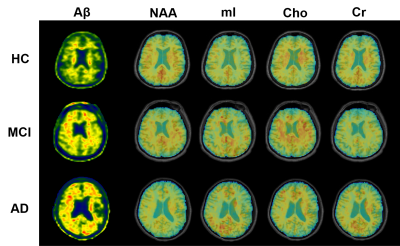 |
Simultaneous 3D 1H-MRSI and PET Imaging Associates Neurometabolism with Beta-amyloid Aggregation in Alzheimer's Disease
Jialin Hu1, Miao Zhang2, Yaoyu Zhang1, Rong Guo3,4, Yudu Li3,4, Yibo Zhao3,4, Ziyu Meng1, Biao Li2, Jun Liu5, Binyin Li5, Jie Luo1, Chao Ma6, Georges El Fakhri6, Zhi-Pei Liang3,4,
and Yao Li1
1School of Biomedical Engineering, Shanghai Jiao Tong University, Shanghai, China, 2Department of Nuclear Medicine, Ruijin Hospital, Shanghai Jiao Tong University School of Medicine, Shanghai, China, 3Beckman Institute for Advanced Science and Technology, University of Illinois at Urbana-Champaign, Urbana, IL, United States, 4Department of Electrical and Computer Engineering, University of Illinois at Urbana-Champaign, Urbana, IL, United States, 5Department of Neurology and Institute of Neurology, Ruijin Hospital, Shanghai Jiao Tong University School of Medicine, Shanghai, China, 6Gordon Center for Medical Imaging, Massachusetts General Hospital, Harvard Medical School, Boston, MA, United States
Beta-amyloid (Aβ) aggregation and neurometabolic changes are biomarkers for Alzheimer’s disease (AD) at early stage. But their underlying relationship in association with AD pathology is still not fully understood. In this study, we simultaneously acquired 3D high-resolution MRSI using SPICE and 18F-AV45-PET images on a PET-MR scanner. Concurrent changes in neurometabolite concentrations and Aβ deposition in healthy control, mild cognitive impairment, and AD groups were compared. An increase in myo-inositol and a decrease in N-acetylaspartate were found as dementia became more severe. Our findings may lay a foundation for further investigation of AD pathogenesis using multimodal metabolic imaging.
|
|||
3718.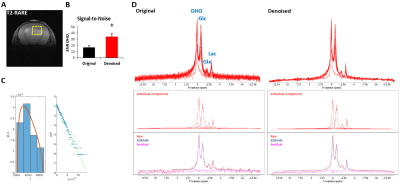 |
Non-invasive assessment of glycolytic and oxidative metabolism in mouse glioma using DGE 2H-MRS
Rui Vasco Simoes1, Rafael N Henriques1, Beatriz M Cardoso1, Francisca F Fernandes1, Jonas L Olesen2, Sune N Jespersen2, and Noam Shemesh1
1Champalimaud Research, Champalimaud Foundation, Lisbon, Portugal, 2Center of Functionally Integrative Neuroscience (CFIN) and MINDLab, Department of Clinical Medicine, Aarhus University, Aarhus, Denmark
Glioblastoma multiforme has been reported to rely both on glycolysis and oxidative metabolism but methods are lacking to assess such heterogenity in vivo. We previously showed a novel application of Marchenko–Pastur PCA denoising (MP-PCA) to dynamic glucose-enhanced deuterium MRS (DGE 2H-MRS). Here, we use this approach to measure glycolytic and oxidative metabolic turnover rates in mouse glioma, thereby assessing their functional metabolic heterogeneity. This methodology can be extended to other cancer models and is available for clinical translation, holding strong potential for improving non-invasive cancer phenotyping and/or assessment of early therapeutic response.
|
|||
3719.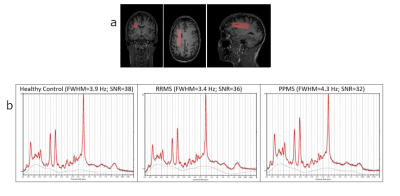 |
1H-MRS of Primary Progressive and Relapsing-Remitting Multiple Sclerosis in brain white matter compared to healthy controls
Bretta Russell-Schulz1, Jasmyne Kassam2, Michael Waine2, Erin L MacMillan1,3,4, Irene Vavasour1, Helen Cross2, Anthony Traboulsee2, Robert Carruthers2, and Shannon Kolind2,5,6
1Radiology, UBC MRI Research Centre, Vancouver, BC, Canada, 2Medicine, University of British Columbia, Vancouver, BC, Canada, 3Philips Healthcare Canada, Markham, ON, Canada, 4Simon Fraser University's ImageTech Lab, Surrey, BC, Canada, 5Physics & Astronomy, University of British Columbia, Vancouver, BC, Canada, 6Radiology, University of British Columbia, Vancouver, BC, Canada
This study establishes pre-treatment baseline metabolite concentrations for a longitudinal clinical trial for RRMS and PPMS using 1H-MRS. The high MRS data quality and similar in FWHM across all participants creates a strong baseline for detecting change over time. Furthermore, knowing the pre-treatment concentration and tracking concentration changes in the MS subtypes compared to a baseline HC group will allow us to learn more about the mechanisms of action of this therapy.
|
|||
3720.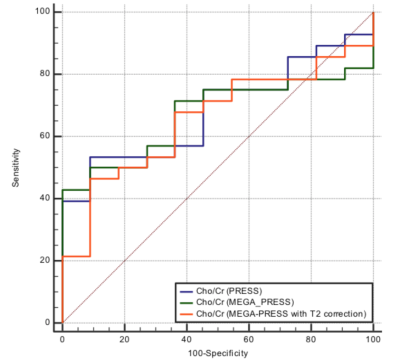 |
Evaluation of the agreement of metabolite levels between PRESS and MEGA-PRESS techniques in the grading of glioma patients
Gerd Melkus1,2, Michael Taccone3,4, Ioana D Moldovan4,5, John Woulfe3,5,6, Gerard Jansen3,7, Ian Cameron1,2, Fahad AlKherayf3,4,5, and Thanh Binh Nguyen1,2
1Medical Imaging, The Ottawa Hospital, Ottawa, ON, Canada, 2Radiology, University of Ottawa, Ottawa, ON, Canada, 3University of Ottawa, Ottawa, ON, Canada, 4Division of Neurosurgery, The Ottawa Hospital, Ottawa, ON, Canada, 5The Ottawa Hospital Research Institute, Ottawa, ON, Canada, 6Division of Neurology, University of Ottawa, Ottawa, ON, Canada, 7Department of Pathology and Laboratory Medicine, The Ottawa Hospital, Ottawa, ON, Canada The main objective of this study is to evaluate the agreement of metabolites between the MEGA-PRESS sequence (analyzing the edit-off spectrum) and a standard long TE PRESS sequence that is used in clinical routine for tumour characterization. The T2 corrected metabolite levels of NAA, Cho and Cr obtained from the edit-off spectrum of the MEGA-PRESS sequence are in good agreement with those obtained from the standard long TE PRESS sequence. No significant difference in the diagnostic accuracy was found. |
|||
3721.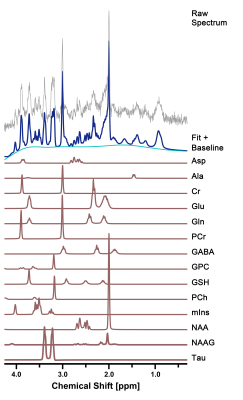 |
Quantification of neurobiological responses in the hippocampus: Towards in vivo neurochemical profiling of cuprizone-induced demyelination
Do-Wan Lee1, Yeon Ji Chae2, Monica Young Choi2, Jae-Im Kwon3, Joongkee Min3, Chul‐Woong Woo3, Hwon Heo2, Dong‐Cheol Woo2,3, Jeong Kon Kim1, Kyung Won Kim1, Hyo Jeong Chin4, and Dong‐Hoon Lee4
1Department of Radiology, Asan Medical Center, University of Ulsan College of Medicine, Seoul, Korea, Republic of, 2Department of Convergence Medicine, Asan Medical Center, University of Ulsan College of Medicine, Seoul, Korea, Republic of, 3Convergence Medicine Research Center, Asan Institute for Life Sciences, Asan Medical Center, Seoul, Korea, Republic of, 4Department of Radiological Science, College of Health Sciences, Yonsei University, Wonju, Korea, Republic of
This study quantitatively measured the changes in metabolites in the hippocampal lesions of a rat model of cuprizone-induced demyelination as detected using in vivo proton magnetic resonance spectroscopy (1H-MRS) at 7-T. The principal findings of the present study were significantly altered concentrations of gamma-aminobutyric acid, glutamate, myo-Inositol, tCr (creatine + phosphocreatine), and Glx (glutamate + glutamine) in the hippocampus of the demyelination-induced rats relative to those in control rats. Our results showed that cuprizone-induced neuronal demyelination may influence the severe abnormal metabolism in hippocampal lesions, and these responses could be caused by microglial activation, mitochondrial dysfunction, and astrocytic necrosis.
|
|||
3722.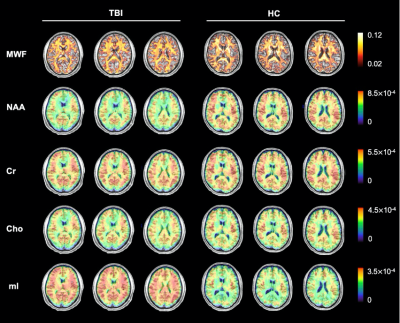 |
Simultaneous Myelin Water Imaging and 3D 1H-MRSI Relates Myelin Degradation to Neurometabolic Changes in Mild Traumatic Brain Injury Patients
Tianyao Wang1, Danni Wang2, Yujie Hu2, Rong Guo3,4, Yudu Li3,4, Yibo Zhao3,4, Jun Liu5, Zhi-Pei Liang3,4, and Yao Li2
1Radiology Department, Shanghai Fifth People's Hospital, Fudan University, Shanghai, China, 2School of Biomedical Engineering, Shanghai Jiao Tong University, Shanghai, China, 3Department of Electrical and Computer Engineering, University of Illinois at Urbana-Champaign, Urbana, IL, United States, 4Beckman Institute for Advanced Science and Technology, University of Illinois at Urbana-Champaign, Urbana, IL, United States, 5Radiology Department, Tong Ren Hospital Shanghai Jiao Tong University School Medicine, Shanghai, China
White matter tracts are known to be highly vulnerable to traumatic axonal injury. Myelin degradation is a major contributing factor for the white matter pathology in traumatic brain injury (TBI), but its relation to neurometabolite alterations is unclear. In this study, we used the latest SPICE technology to perform simultaneous 3D high-resolution MRSI and myelin water imaging to assess the relationship between myelin degradation and neurometabolic changes in acute mild TBI (mTBI) patients. Our results showed coupled MWF and NAA reductions in occipital CC tract of the patients, which provides new insights into TAI pathology in acute mTBI.
|
|||
3723.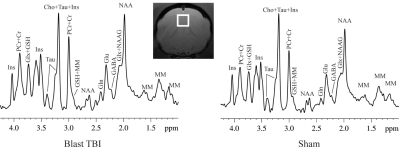 |
Biochemical and behavioral alterations in a ferret model of blast related mild traumatic brain injury
Shiyu Tang1,2, Su Xu1,2, Donna Wilder3, Joseph Long3, Venkata Siva Sai Sujith Sajja3,4, and Rao Gullapalli1,2
1Department of Diagnostic Radiology and Nuclear Medicine, University of Maryland School of Medicine, Baltimore, MD, United States, 2Center for Advanced Imaging Research (CAIR), University of Maryland School of Medicine, Baltimore, MD, United States, 3Blast Induced Neurotrauma Branch, Walter Reed Army Institute of Research, Silver Spring, MD, United States, 4The Geneva Foundation, Tacoma, WA, United States
We studied the longitudinal changes in brain metabolism and impulsivity behavior in ferrets, a gyrencephalic animal model subjected to novel blast exposure conditions that closely mimic those encountered by Warfighters. Compared to rodents, the ferret model has greater similarities to human in terms of developmental process, brain structure and sophisticated behavior. Ferrets demonstrated increased behavioral impulsivity and higher glutamate and taurine in prefrontal cortex following blast exposure. Our findings are in agreement with clinical observations in patients, suggesting that this model is a good gyrencephalic animal model to study brain biochemical profile changes and neuropsychiatric alterations associated with blast exposure.
|
|||
3724.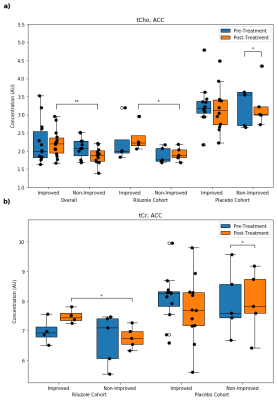 |
Longitudinal Neurochemical Changes of Riluzole Therapy in Post-Traumatic Stress Disorder
Sam H. Jiang1, David M. Benedek2, Patricia Spangler2, James West2, Catherine L. Dempsey2, Ashley Phares2, Brian Andrews-Shigaki3, Eduardo Coello1, and Alexander P. Lin1
1Center for Clinical Spectroscopy, Brigham and Women's Hospital and Harvard Medical School, Boston, MA, United States, 2Uniformed Services University of the Health Sciences, Bethesda, MD, United States, 3Office of Naval Research, United States Navy and Marine Corps, Alexandria, VA, United States
Active duty service members and veterans with post-traumatic stress disorder (PTSD) refractory to evidence-based therapy were randomized to receive either riluzole, a glutamate modulator, or placebo adjunctive to selective serotonin reuptake inhibitor therapy over an 8-week period. Subjects underwent 1H brain magnetic resonance spectroscopy scans pre- and post-treatment and were assessed longitudinally for PTSD symptomology using the Clinician-Administered PTSD Scale (CAPS). Subjects were stratified into improved and non-improved groups based on a decrease in CAPS score. Analyses on within- and between-group metabolite differences revealed that riluzole modulated the glutamate-glutamine cycle, improved neural energetics, and may have induced choline-linked neuroprotective inflammation.
|
|||
3725.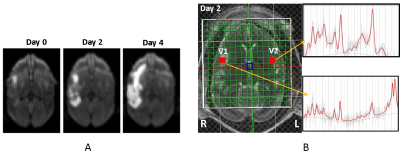 |
Temporal correlation of functional connectivity and Choline in the monkey brain following ischemic stroke
Chun-Xia Li1, Frank Tong2, Doty Kempf1, Leonard Howell1, and Xiaodong Zhang1
1Yerkes Imaging Center, Yerkes National Primate Research Center, Emory University, Atlanta, GA, United States, 2Department of Radiology, Emory University, Atlanta, GA, United States
Previous studies have suggested cerebral Choline (Cho) is a sensitive marker of acute stroke and could protect the tissue from ischemic injury. Also the relative connectivity (RelCon) could be a robust index to reveal the functional connectivity changes using resting state fMRI (rs-fMRI). The results indicated progressively increased RelCon in secondary somatosensory cortex (RelCon-S2) and a significant positive correlation between RelCon-S2 and relative cerebral Choline level (RelCho) from hyper-acute phase to 96 hours post stroke. The RelCon and RelCho combined detection might be an optimized and promising approach in management and prediction of stroke recovery.
|
|||
3726.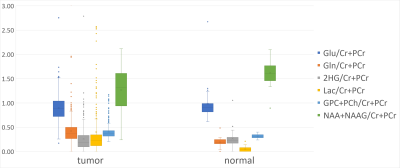 |
Standard Frame of Reference for the Identification of Metabolic Phenotypes of Brain Tumors using Single Voxel MR Spectroscopy
Eduardo Coello1, Victoria Sanchez1, Marcia Louis1, Huijun Liao1, Sam Jiang1, Wufan Zhao1, Katherine M. Breedlove1, Raymond Huang1, and Alexander Lin1
1Radiology, Brigham and Women's Hospital, Boston, MA, United States
This work introduces a reference frame for the evaluation of single-voxel spectroscopy scans of brain tumors. The goal of this work is to stratify the classification of spectra based on metabolic features to maximize their specificity. The method was developed using decision trees and tested with different sample classifications that included tumor vs. non-tumor voxels and IDH vs. non-IDH tumors.
|
|||
3727.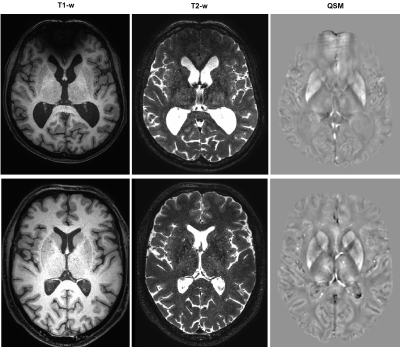 |
GABA and Susceptibility Changes in Striatum in Liver Cirrhosis: Preliminary Results
Gasper Zupan1,2, Sebastian Stefanovic3, Marjana Turk Jerovsek3, Borut Stabuc3, Georg Oeltzschner4,5, Stefan Ropele6, Dusan Suput1, and Andrej Vovk1
1Faculty of Medicine, University of Ljubljana, Ljubljana, Slovenia, 2Institute of Radiology, University Medical Center Ljubljana, Ljubljana, Slovenia, 3Department of Gastroenterology and Hepatology, University Medical Center Ljubljana, Ljubljana, Slovenia, 4Russell H. Morgan Department of Radiology and Radiological Sciences, The John Hopkins University School of Medicine, Baltimore, MD, United States, 5M. Kirby Research Center for Functional Brain Imaging, Kennedy Krieger Institute, Baltimore, MD, United States, 6Department of Neurology, Neuroimaging Research Unit, Medical University of Graz, Graz, Austria Liver cirrhosis (LC) is a worldwide public health problem. One of the complications of LC is hepatic encephalopathy which can present only as subtle cognitive impairment. Using advanced MR methods (MEGA-PRESS Spectroscopy and Quantitative Susceptibility Mapping), decreased striatal GABA levels, decreased susceptibility in caudate nucleus and increased susceptibility in putamen were demonstrated in LC patients compared to healthy controls. GABA levels and susceptibility in putamen correlated with the results of neuropsychological tests in the LC group compared to healthy controls. |
|||
3728.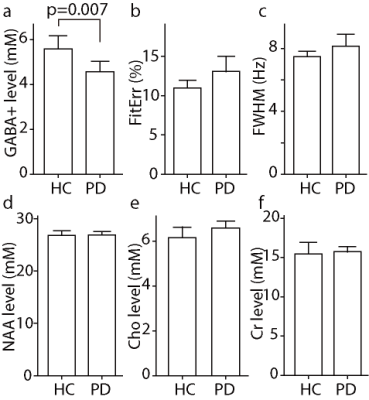 |
Upper brainstem GABA levels in Parkinson’s disease
Yulu Song1, Tao Gong1, Muhammad G. Saleh2,3, Mark Mikkelsen2,3, Guangbin Wang 1, and Richard Edden2,3
1Shandong Medical Imaging Research Institute, Shandong University, jinan, China, 2Russell H. Morgan Department of Radiology and Radiological Science, The Johns Hopkins University School of Medicine, baltimore, MD, United States, 3FM Kirby Center for Functional Brain Imaging, Kennedy Krieger Institute, baltimore, MD, United States
The aim of this study is to test the hypothesis that levels of gamma-aminobutyric acid (GABA) in the upper brainstem are reduced in patients with PD compared to healthy controls, using edited magnetic resonance spectroscopy (MRS of GABA+). GABA+-edited MRS was performed in 7.5-ml voxels in the upper brainstem in 18 PD patients and 18 age- and sex-matched healthy controls (HCs), and the spectra were processed using the Gannet software. The lower GABA+ levels in the upper brainstem of the PD patients suggest that a GABAergic deficit in the brainstem may contribute to the dopaminergic pathology in PD.
|
|||
3729.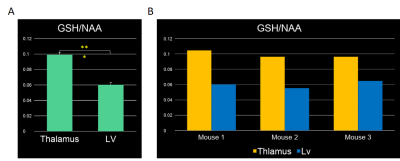 |
In vivo detection of GSH in the mouse brain using MEGA-PRESS at 9.4T
David Jing Ma1, Sabrina Gjerswold-Selleck2, Yanping Sun3, Matt Mattingly Mattingly4, and Jia Guo5
1Biomedical Engineering, Columbia University, New York, NY, United States, 2Columbia University, New York, NY, United States, 3Herbert Irving Comprehensive Cancer Centre, Columbia University, New York, NY, United States, 4Bruker BioSpin, Billerica, MA, United States, 5Department of Psychiatry, Columbia University, New York, NY, United States
Glutathione (GSH) is an important intracellular antioxidant in the brain. Various clinical human studies report its measurement by localized 1H spectroscopy using MEGA-PRESS and achieve high reliability and accuracy of GSH measurements at 3 T. As of today, animal model studies conducted at higher fields significantly enhance the armamentarium of tools available for the probing brain function and brain pathologies. However, even though mice are widely used in research, limited studies of GSH in mouse models are conducted. In this study, we demonstrate that MEGA-PRESS is a feasible technique to measure GSH in the mouse brain in vivo at 9.4T.
|
|||
3730.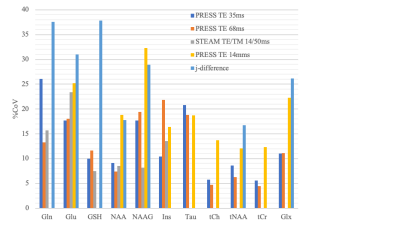 |
Reproducibility of metabolite measurements in the preterm brain using magnetic resonance spectroscopy
Subechhya Pradhan1,2,3, Sudeepta Basu4, Kushal Kapse1, Devon Fisher1, Stephanie Norman1, and Catherine Limperopoulos1,2,3
1Developing Brain Institute, Children's National Hospital, Washington, DC, United States, 2Radiology, Pediatrics, George Washinton University, Washington, DC, United States, 3Radiology and Diagnostic Imaging, Children's National Hospital, Washington, DC, United States, 4Neonatalogy, Children's National Hospital, Washington, DC, United States
Preterm brain metabolism studies using magnetic resonance spectroscopy (MRS) demonstrate an association between abnormal biochemistry and brain injury. To our knowledge, there are no reports on the reproducibility of these measurements as well as the optimal pulse sequence to measure each metabolite in the preterm brain. In this study, results of same-session reproducibility of metabolite concentration measurements from 15 preterm scanning sessions using 4 different pulse sequences are presented.
|
|||
3731.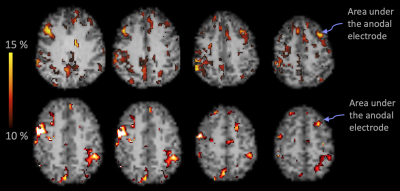 |
Quantitative measurement of changes in 23Na MRI following transcranial direct current stimulation (tDCS) of the motor cortex
Iris Asllani1,2, Francesco Di Lorenzo1, Balazs Orzsik1, Guillaume Madelin3, Neil Harrison4, and Mara Cercignani1
1University of Sussex, Brighton, United Kingdom, 2Rochester Institute of Technology, Rochester, NY, United States, 3New York University, New York, NY, United States, 4University of Cardiff, Cardiff, United Kingdom
23Na MRI data were acquired on healthy volunteers ~15 mins after either anodal, cathodal, or sham application of tDCS in the motor cortex. Tissue specific [Na] concentration images were obtained using a partial volume correction algorithm previously developed for ASL MRI. There was an average 14% increase in gray matter sodium concentration, [Na]GM, across the group following the anodal tDCS; no significant change was observed for the sham application. Of note, all subjects exhibited a widespread pattern of increased [Na]GM similar to that reported in ASL MRI studies that have measured changes in CBF also following anodal tDCS of M1.
|
|||
3732.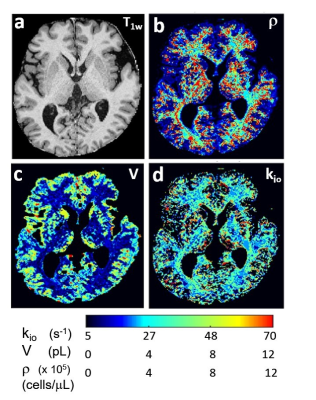 |
Non-Invasive Brain Metabolic and Cytometric Imaging: Insights from Activity MRI [aMRI]
Charles S. Springer1, Brendan Moloney1, Eric Baker1, Martin M. Pike1, and Xin Li1
1Advanced Imaging Research Center, Oregon Health & Science University, Portland, OR, United States
The first aMRI [activity MRI] maps of the awake, heathy human brain are presented. They show differences in cell density [ρ (cells/μL)], average cell volume [V (pL)], and on-going metabolic activity among different brain tissues. Metabolic activity is represented by the mean steady-state cellular water efflux rate constant [kio], which reflects homeostatic cytolemmal Na+,K+-ATPase [NKA] enzymatic turnover. Cortical gray matter [GM] ρ is less than white matter [WM] ρ, while VGM > VWM. Most interesting is the quite large WM kio, 30 s-1. WM NKA activity per cell is considerably larger than in cortical GM.
|
The International Society for Magnetic Resonance in Medicine is accredited by the Accreditation Council for Continuing Medical Education to provide continuing medical education for physicians.